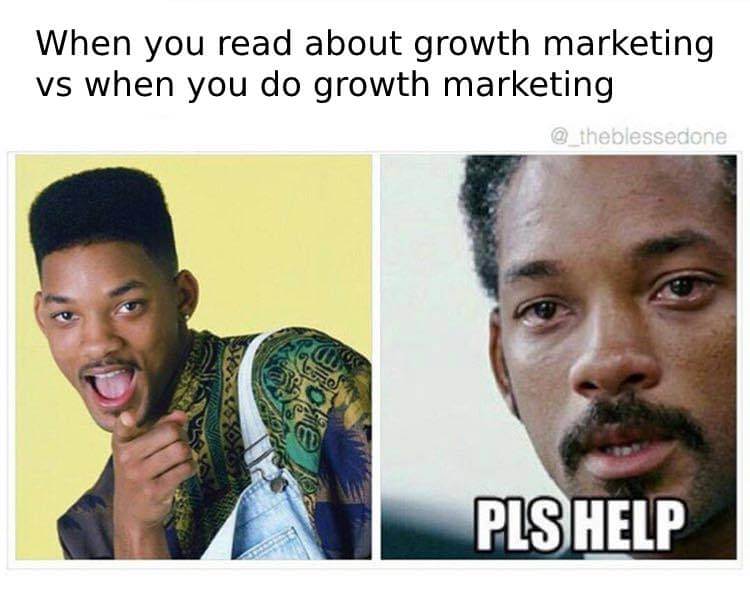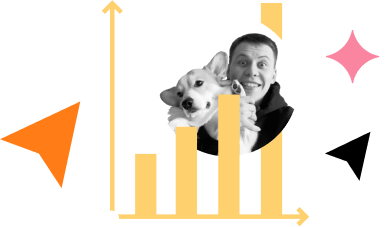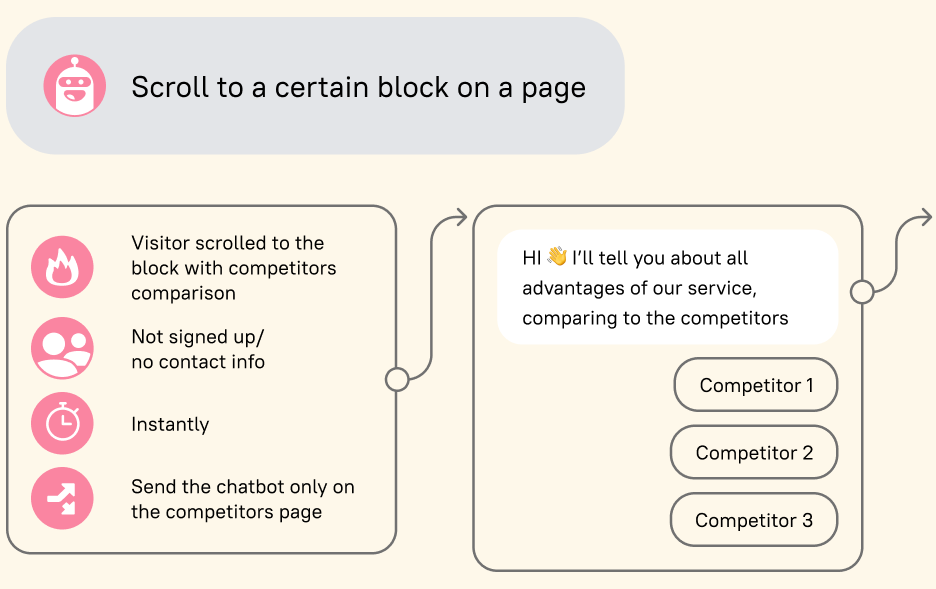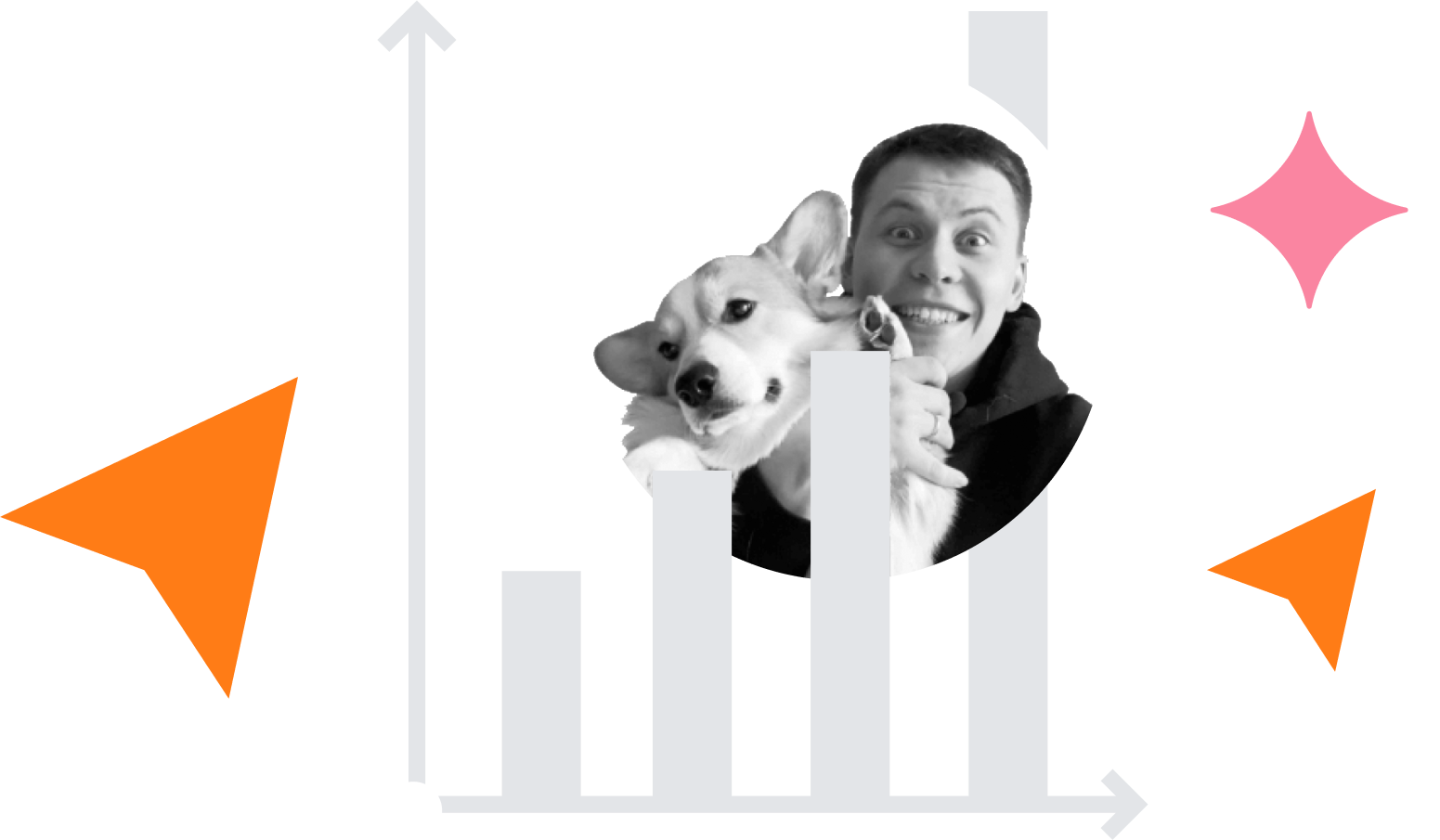The ultimate guide to growth marketing explained by a growth hacker
Discover the secrets of rapid business growth from a growth marketing expert. What people to hire, how to manage a team, launch experiments, what tools to use, and a list of proven examples to inspire you.

Part 1: Guide to growth marketing explained by a growth hacker
Part 3: Guide to hacking your product led growth marketing
Part 4: 3 rules and 5 must-have roles when building growth marketing team
Part 5: How to produce growth hypotheses
Part 6: Your growth marketing strategy template, guide, and examples
Part 10: A secret collection of growth marketing tools
Part 12: 25 Growth Marketing Books
“Growth marketing” is a strategy that allows a brand to hack its growth and achieve rapid results. It is like using cheat codes in a computer game.
To define that cheats to hack marketing and growth, you need to analyze the current funnel, customer journey, lifecycle, then create and test ideas to attract more clients and increase profit.
“Pfff, easy!” ─ That was the first thought that came to my mind. Since my experts has always been striving to introduce new approaches Jobs to be Done, Objective Key Results, agile sprint frameworks, it didn’t take long to agree to try something new. However, after the first month, my opinion changed from “This is a piece of cake!” to “What a nightmare!”.
Spoiler — both are true.
Now, together with a team, I generate 33% demos. In 2021, at the beginning of my path, my head was full of questions: What type of tests to run? What funnel stage to focus on? What people to invite to a team?
Growth marketing is far beyond the definition. I’ll show you its true face: my team, daily tasks, ideas to focus on, and possible pitfalls.
But first, let’s check if we’re on the same page about basics.
Want more guides? Here is the Dashly collection. Learn everything about:
What is growth marketing
It’s about growing a business using an innovative, data-driven growth marketing strategy.
You know that traditional marketing is all about short-term goals. Growth marketing is different — it’s in it for the long haul. It’s like a savvy friend who looks at the whole picture, from getting new customers to keeping them happy and returning for more.
How does it work? Growth marketers mix creative strategies, analytics, and experimentation to make the magic happen. They’re constantly testing and tweaking their tactics to get the most bang for their buck. Imagine having a secret recipe that gets better with each tweak.
Quick example from Airbnb
They really nailed it when they integrated with Craigslist, a popular classifieds site. By allowing customers to cross-post their listings on Craigslist easily, they tapped into a vast audience interested in short-term rentals.
Smart move, right?
From its launch in 2008, Airbnb hit 1 million bookings by early 2011. Fast forward to 2017, they’d served over 200 million guests. And by 2021, they had a staggering 5.6 million active listings in 220 countries. So, Airbnb’s story shows how thinking outside the box and optimizing user experience can lead to impressive growth. It’s a perfect example of a growth marketing strategy in action!
To understand it better, let’s look at it compared to traditional marketing.
Growth marketing vs traditional marketing
The first is a more comprehensive, experimental, and long-term approach to digital marketing that prioritizes the entire customer journey, cross-channel integration, and continuous optimization.
| Traditional marketing | Growth marketing | |
| Focus | Specific channels and tactics, like SEO, PPC, or social media, to drive customer acquisition and brand awareness. | Entire customer journey, from acquisition and activation to retention and referral, to drive sustainable long-term growth. |
| Goals | Short-term goals, like increasing sales or customer loyalty for a specific campaign. | Long-term success by continuously improving the customer experience and fostering loyalty leads to more referrals and repeat business. |
| Experiments | Generally lacks the same level of iterative experimentation and data-driven optimization. | Continuous testing, learning, and optimization to improve performance across the entire customer lifecycle. |
Growth marketing vs growth hacking
| Growth marketing is a holistic approach that takes care of the customer journey like a loving parent supporting their child through all life stages. | Growth hacking is more like a cool uncle who swoops in with a neat trick or hack to achieve rapid successful growth in a specific area. |
Growth hackers often have a mix of skills, including marketing, product management, and data analysis, and they use these skills to develop creative solutions to acquire, retain, and engage customers. They prioritize high-impact, scalable tactics and constantly test, measure, and iterate to optimize achieved effect.
Here are the main differences between them:
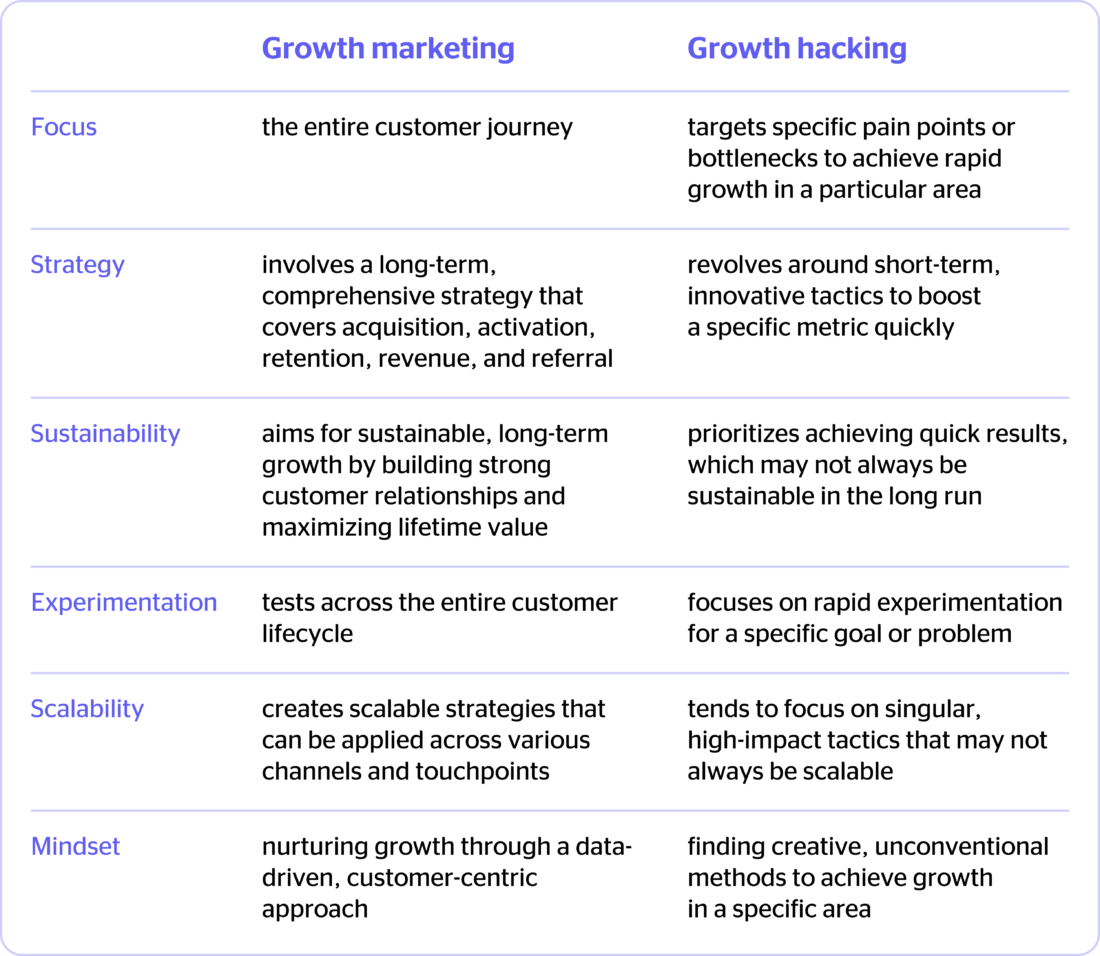
Quick growth hacking example from Hotmail
They added a simple line at the bottom of every email sent by a Hotmail user: “PS: I love you. Get your free email at Hotmail.” It was a tiny yet brilliant move! People who received emails from Hotmail would see this message and feel inclined to sign up for their free email account.
The result?
This hack helped Hotmail go viral, with its customers base skyrocketing from 20,000 to 1 million in just six months. And in under two years, Microsoft acquired them for a cool $400 million. Not too shabby, right? It’s a classic example of simple yet powerful experiments that made a huge impact!
Both have their place.
Read my guide to growth hacking in 2023.
And the last definition that may confuse you 👇
Growth marketing vs. product-led growth
Growth marketing manager is a talented chef who creates an entire menu, combining various ingredients and techniques to offer a delightful dining experience. The chef focuses on every detail, from appetizers to desserts, ensuring each dish is delicious and harmonious.
On the other hand, product-led growth is like a secret sauce that turns a good dish into a culinary masterpiece, making people rave about it and return for more.
When growth marketing is about crafting a comprehensive tactic to cover the entire customer journey, product-led growth zeroes in on the product itself, making it irresistible and user-friendly that it becomes the main driver of growth.
Let’s zoom in on the key focus areas of Product Led Growth Marketing (PLG):
1️⃣ User Experience (UX): PLG is all about putting the user first, ensuring that the interface is intuitive, easy to use, and solves a real problem of customer led growth. A seamless and enjoyable user experience is the foundation of product-led growth.
2️⃣ Onboarding: A smooth onboarding process is crucial to show new customers the product’s value quickly. PLG aims to help customers reach their “Aha!” moment as fast as possible when they truly offer value.
3️⃣ Virality: PLG strategies often include built-in virality when users share a word about a brand with others. This can be through referrals, social sharing, or collaboration features that expose a service to more potential customers.
4️⃣ Self-Serve Model: Product-led growth often relies on a self-serve model, allowing customers to sign up, explore, and even purchase without needing sales assistance. This empowers customers to experience the product’s value firsthand before committing.
5️⃣ Feedback and Iteration: Listening to user feedback and continuously iterating is essential in PLG. The product becomes more valuable and indispensable over time by staying in tune with users’ needs and addressing their pain points.
6️⃣ Data-Driven Decisions: A successful PLG tactic leverages data to understand user behavior, optimize the product, and make informed decisions about future improvements or new features.
In summary, the critical focus of PLG is on delivering an exceptional user experience, facilitating smooth onboarding, creating virality, offering a self-serve model, gathering feedback, and making data-driven decisions for non-stop improvements.
There are more: demand generation vs growth marketing and growth marketing vs performance marketing.
Ok, so where to start?
My journey began with building a team.
Dream team to skyrocket your brand
Dashly required a team of reliable and creative business growth experts who would not be afraid to offer crazy hypotheses, test, scale them, and learn from their failures.
And I found my perfect growth marketing team:
🐻❄️ Two pay-per-click specialists are in charge of ad campaigns.
🦊 Designer who created visual elements for ads and tests.
🐯 Marketer who was helping to analyze hypotheses and their results. Important note: this expert was outsourced from a marketing department to play a “fresh eye” role.
🐺 Analyst who was responsible for collecting statistics and monitoring crucial KPIs.
🐰 Scrum master in charge of the workflow: daily reminders, brainstorming sessions, testing time, etc.
🙉 And me as a team lead. I’m that person who looks for insights and generates hypotheses.
Each of them is a true expert. It seemed we could do anything together. Guess how fast that anything turned to nothing? In the beginning, we couldn’t even agree on something. For example, Facebook ads: Is each offer a particular hypothesis or an ad group?
So before a start, we spend a lot of time learning to build processes in a team: how to state, discuss, and test hypotheses correctly. Then, we set new rituals like meetings and hypothesis pitching.
Finally, we are ready to hack any business growth! But where to start?
Marketing Growth Strategy
Do you know what Dashly is famous for except for its products? Love to our clients. So when I started growth marketing at Dashly, I used to compare this process to dating 🍷
Try this approach:
1️⃣ First things first, you’ve got to know your audience. It’s like dating; you don’t want to attend a vegan restaurant with your carnivorous date, right? Research your target audience and discover what makes them tick (or laugh!).
2️⃣ Next, set clear goals. You can’t hit a bulls-eye without knowing where the target is! And just like trying to find a matching sock in the laundry, ensure you’re looking for something achievable and realistic.
3️⃣ Time to dig into the data! Analyze your current performance like Sherlock Holmes on a sugar rush. It’s elementary, my dear marketers — find out what marketing campaigns work, what don’t, and what you can improve.
4️⃣ Now, brainstorm and experiment with different marketing channels and tactics. You know what they say: variety is the spice of life! Like mixing up dad jokes with knock-knock jokes, keep things fresh and engaging for your audience.
5️⃣ Don’t forget to measure and optimize. After all, what’re marketing strategies without a magnifying glass to see what’s hot and what’s not? If a tactic is as effective as a screen door on a submarine, tweak it or toss it!
6️⃣ Finally, keep an eye on the competition. Like checking out your neighbor’s Halloween decorations, knowing what they’re up to is always good. Learn from their successes and avoid their pitfalls!
There you have it! Building a marketing growth strategy is like creating a comedy routine: know your audience, set goals, analyze data, mix things up, optimize, and stay on your toes. With these steps, you’ll be laughing all the way to the bank!
Some marketers visualize this process in growth loops, others in growth hacking canvas like this one:
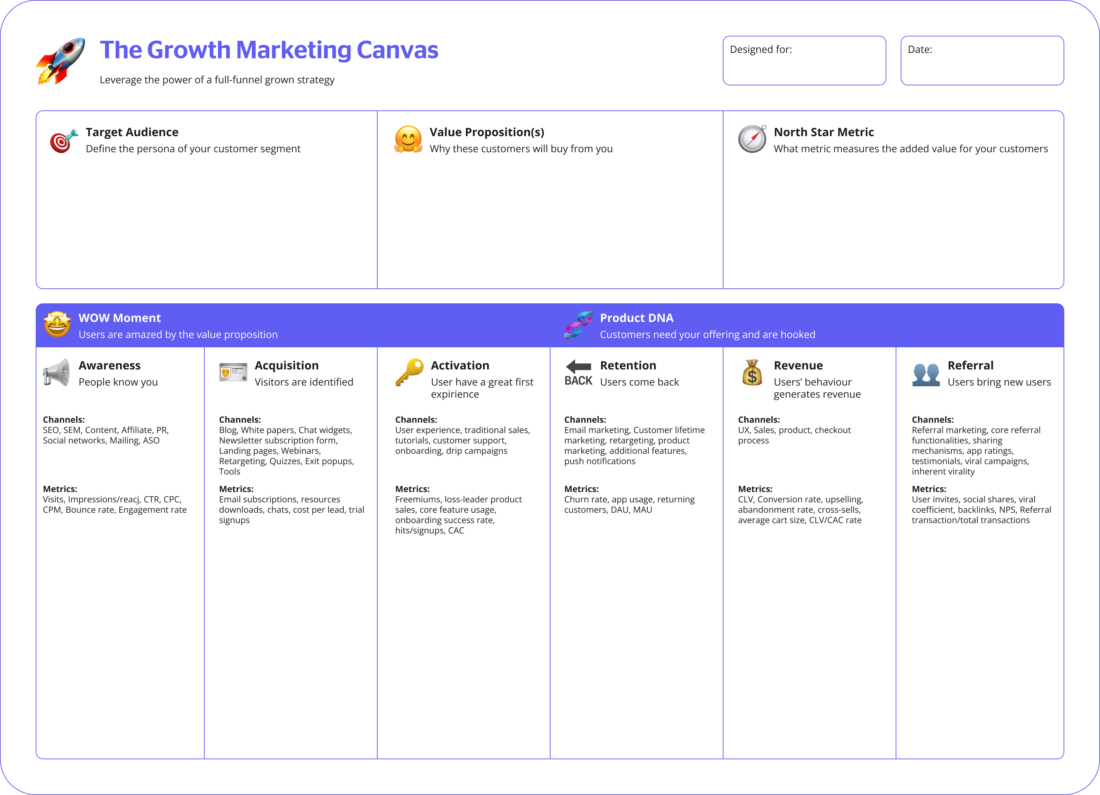
This growth marketing strategy template can be a great start for building your business growth plan.
Sure thing, it is a general go-to guide. You should adjust it to your industry and channels. For example, B2B Growth Hacking Strategies differ from B2C, and the SaaS growth hacks Facebook is not the same as email.
Thanks! Here’s your copy of the growth marketing strategy template

And finally, my fav creative part.
Growth marketing hypothesis testing
Not to get lost in the variety of ideas, find your focus. For example, Dashly company works with AAARRR funnel framework, so usually, we have a list of hypotheses for each stage:
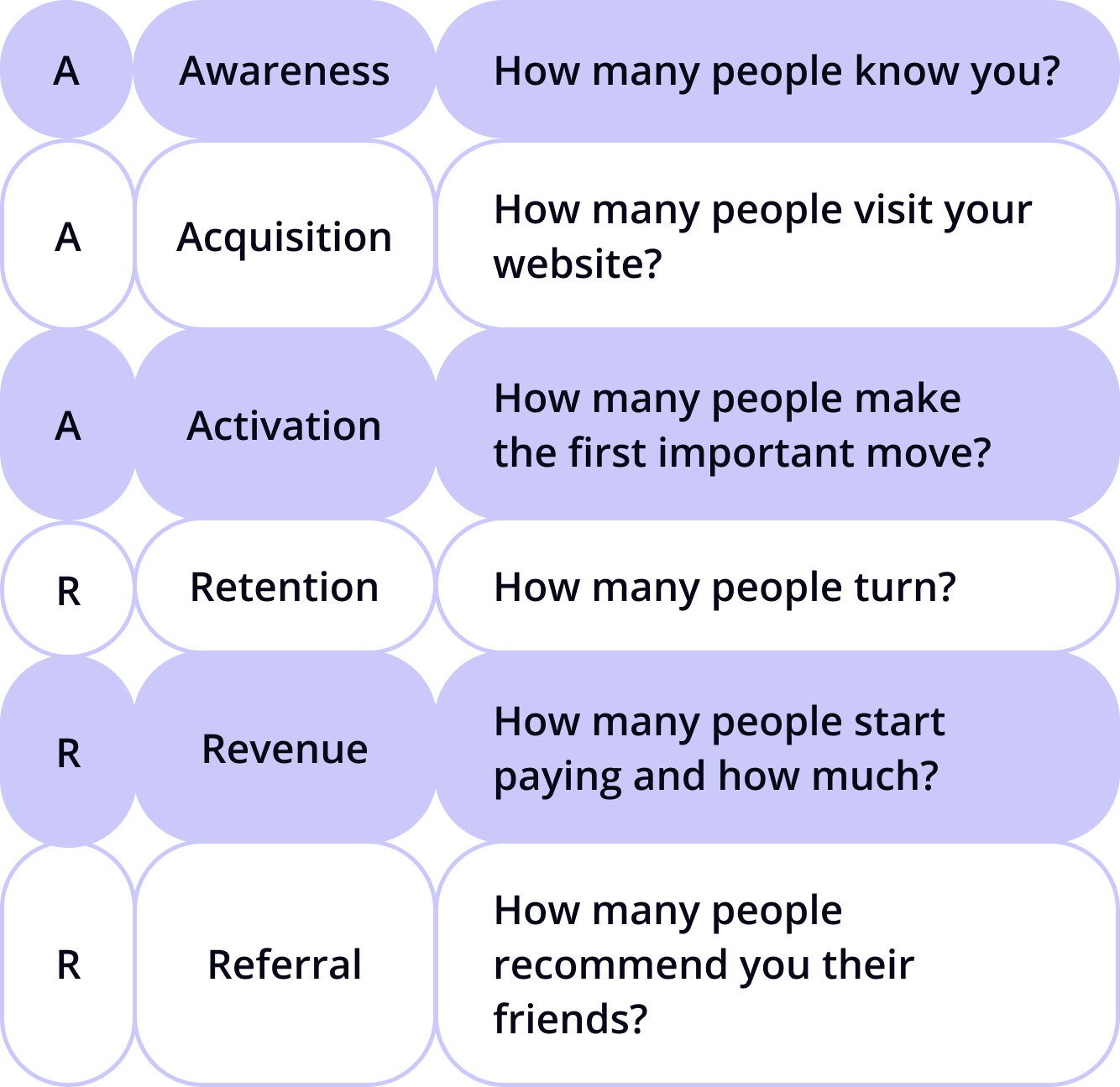
But you can’t just test all of them at once. Focus is crucial for a growth marketing campaign.
We chose the funnel stage to work on each quarter, following the strategic brand goals. For example, the first time was the most painful part ─ user activation. We wanted to increase the number of customers discovering Dashly use cases.
The first growth hacking hypotheses. What data you need
To turn a thought into a hypothesis, it’s essential to understand how much time and money the company is willing to invest. Also, what do you want to change, which benchmarks will you evaluate, and what impact to expect?
So many questions. Heh? But it is significant to answer them all. So that is what we do before the start of each hypothesis test.
1. Hypotheses generation. This is where the magic begins. The teammates discussed an idea they found during competitors’ or other teams’ research. In practice, it looked like this:
IF we do this, THEN we get that.
For example: If we run a chatbot on the primary page offering to download the competitor matrix with Dashly and other products, the conversion rate will be 1.5% and more. Then we shape it by answering the following questions:
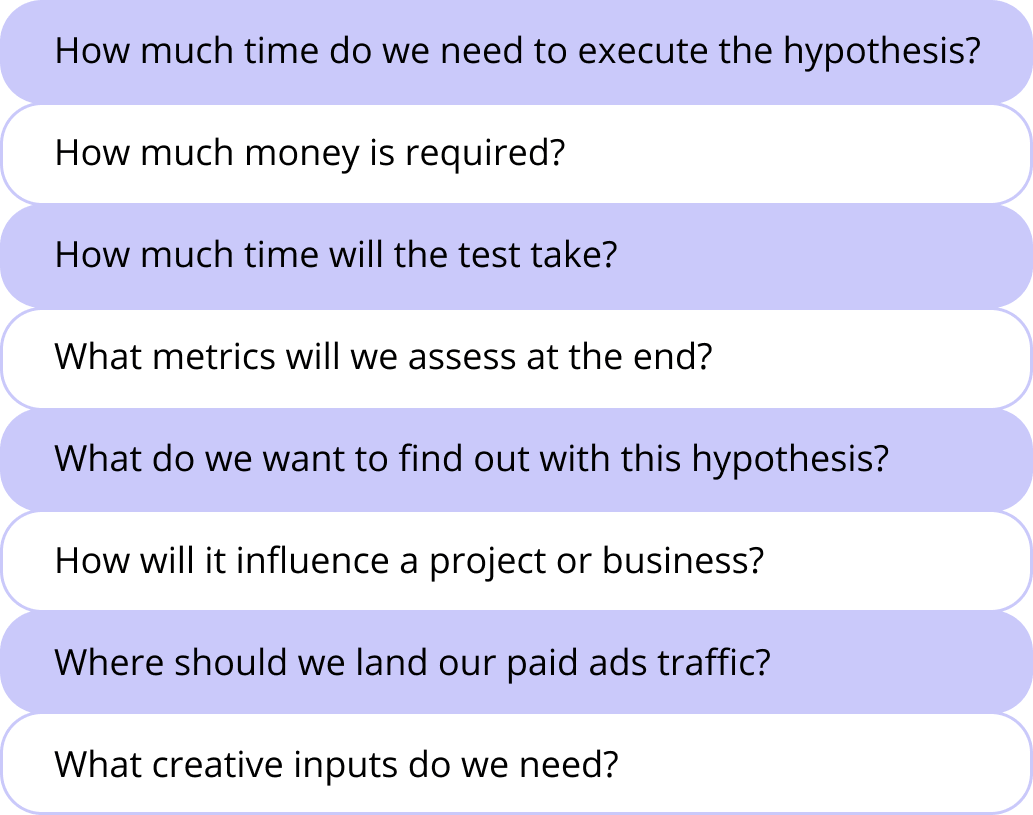
As a result of this step, we had a card for each hypothesis that identified the main idea, timing, channels, funnel stage, and who was responsible.
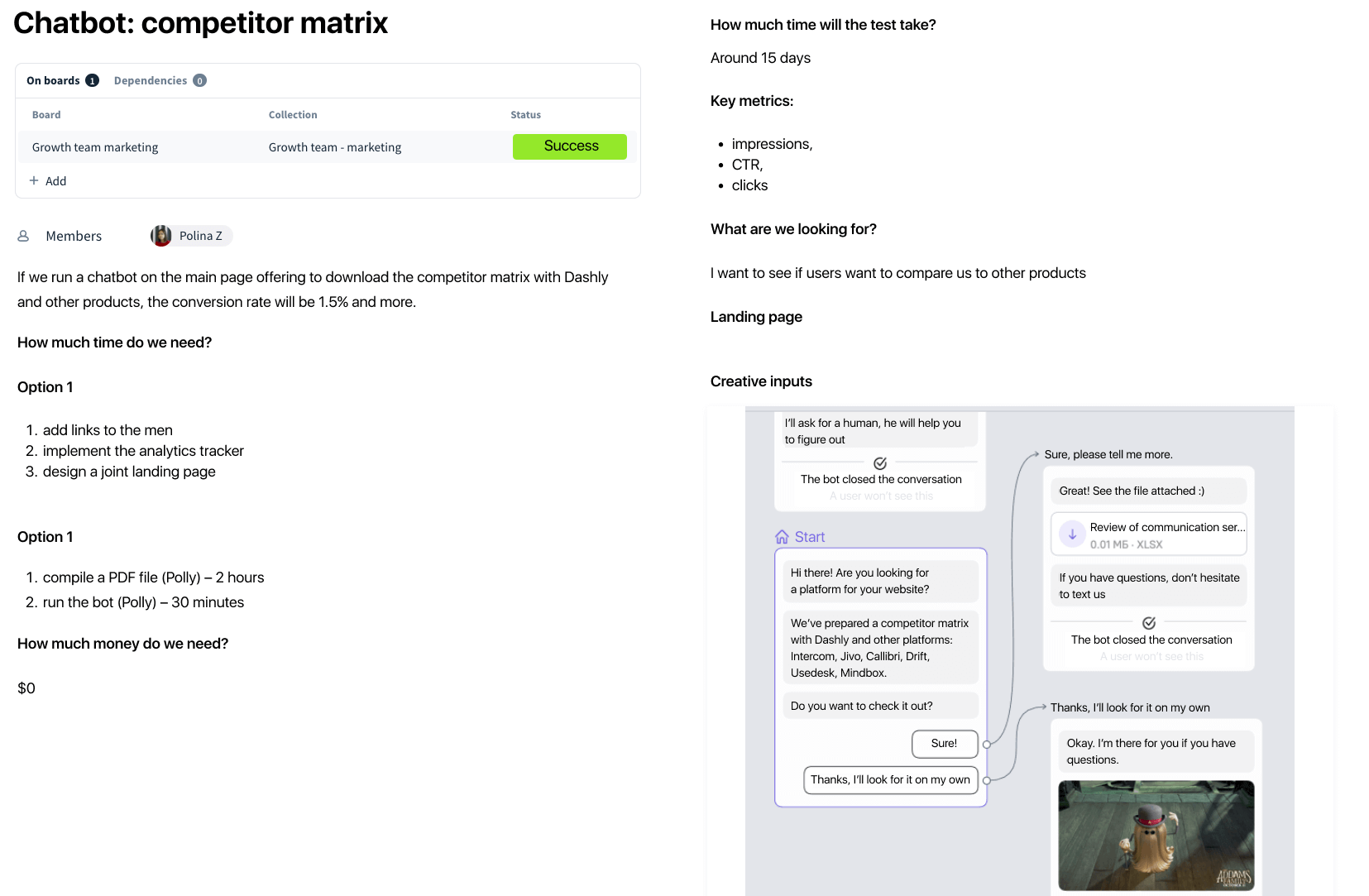
2. Discussion. In the regular meetings, we discussed the hypotheses for improving, rejecting, or scaling some of them. Then, as a part of this sprint, each teammate had 3 minutes total to sell the idea.
After this, we usually had a list of 10-15 hypotheses to test.
3. Syncing up with related teams. At this stage, we warn other departments about possible changes they may experience during the test. For instance, sales managers may get more leads from a particular ad campaign.
4. Production and testing. My department has estimated a maximum of six hours for launching a new hypothesis by using an MVP approach. This way, we wouldn’t simultaneously put everything on the table and waste valuable resources. But instead, test the waters to see what works.
5. Analytics. To check if the hypotheses worked as expected, we looked at the dashboard in Rick’s analytics platform (CTR, CPC, CR, etc.) and Dashly, as we tested many of our hypotheses with it.
For example, we monitor our email and chatbot performance there.
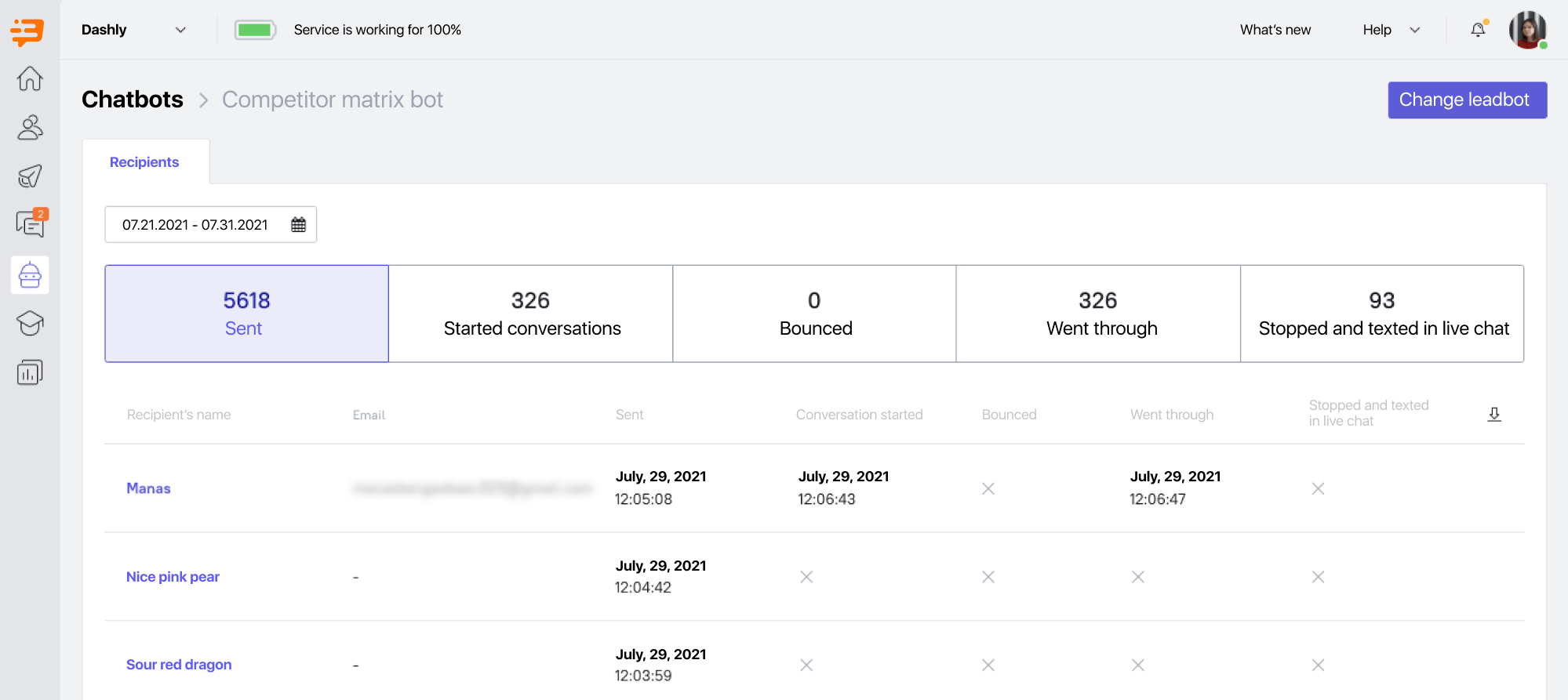
Based on the received data, the team should decide whether the hypothesis worked and is worth repeating with changes. Or it failed, and they need to analyze the reasons. In this case, failure, as well as success, helps draw conclusions and original polish ideas.
Read more about growth marketing analytics.
Want more ideas for your growth experiments? 👇
What happens after testing?
We found out that some hypotheses worked. And some don’t. For example, our email campaign with an invitation to our event. We wanted to generate 30 registrations.
But we only get 5. What a failure!
I saw the 3% open rate when we analyzed the campaign effect. Recipients didn’t even see our offer. So I tested the campaign again with a more appealing email subject. If the hypothesis didn’t work out after all this, we would reject it.
But this one was successful, so we scaled it to paid channels.
The first success of the growth marketing strategy
Overall, from day one till today, Dashly marketers achieved remarkable success:
My experts tested 10 ideas every week. It is 215 hypotheses in 5 months!
In case you’re still not impressed: now we attract 33% of leads for platform demos that sales reps make.
Ups and downs have taught me what being a true growth marketer means.
Growth marketing key metrics
Having been on the market since 2014, Dashly has had over 5000 clients worldwide. But the company needed to grow faster. And we focused on raising yearly income. This goal could be reached by driving more customers, minimizing churn, and increasing sign-up conversion.
Dashly growth marketers are focused on the sales funnel. To be more specific, I should increase the number of:
- Demo sessions that have been completed.
- Closed deals.
- Demo requests.
So I’m working on an ultimate guide to all possible experiments KPIs for your growth plan. I’ll add it below in a while. Subscribe, not miss it 👇
Welcome to the club! Soon, I’ll send you the first email

Quick tips for successful growth marketing from Dashly marketers
After five years of testing conversational marketing, my team collected a long list of tips. We lost a lot of time and money discovering them. So enjoy:
👉 Growth marketing is impossible without an in-depth understanding of your buyer personas, and ideal customer profile. For a quick start, use ready-made templates.
👉 Next step is visualizing a customer journey map. You should know your customers behavior and how they buy.
👉 Thus, you can test different customer segments of your base and personalize offers/messaging. For example, the Dashly uses three types of customer segmentation during hypothesis testing.
👉 Align the work of marketing and sales departments. Because once, you’ll find marketers spending thousands of dollars on low-quality campaigns and sales reps wasting time on customers who won’t buy anything.
Read also: RevOps vs Sales Ops and RevOps TechStack
Growth marketing examples
Growth marketing example 1: Engage in the conversation on landing pages
Landing pages are a vast field for experiments. Sure, they present your brand from the best side. But many companies miss a chance to talk to prospects at this journey stage.
It was precisely the case for our EdTech customer Learn-E. A lot of leads wandered around their courses’ landing pages, but most of them were left unqualified and were lost forever.
Chatbot became the solution. It’s a virtual assistant that automatically engages visitors in the conversation, qualifies them, and collects contact details.
Later, a qualified lead is passed to the sales team. And sales reps have all the necessary information about a person to present the most relevant offer.

As a result, the Dashly chatbot helped increase the conversion rates on landing pages and client loyalty. It brought the company $145k, and the chatbot paid off in just five leads!
Want more? Grab your free growth marketing playbook.
Growth marketing example 2: Let customers know the value
We got this insight while working with an online platform for Instagram account growth. They wanted to increase conversion to signup and an account audit.
They used a triggered message in a live chat to engage site visitors. Dashly implementation team offered an alternative solution — a chatbot.

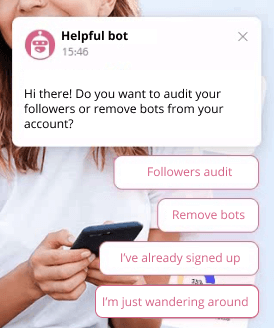
Instead of offering a vague account audit, the chatbot delivers the specific value of the audit feature to website visitors. And reminds them to sign up for the platform too!
As a result, the conversion to running the audit increased from 56.4% to 74.3%. The implementation team also helped increase the conversion rate to signup to 70%!
Growth marketing example 3: Guide users after they sign up
Did you convert a user to signup? Congrats! Now your task is to make them stay and convert into buying a subscription or paying for specific features.
If you sell a complicated SaaS service, users might have difficulty figuring it out. It can discourage them from using your service.
Read more on B2B growth marketing.
Our customer, a CPA network with quite a tricky learning curve, wanted to encourage users to place referral offers. But to do it, their people needed to get acquainted with the service first.
They chose a chatbot for this task. So, when a user signed up for the service, the chatbot:
- showed them around the interface;
- learned about their experience with other CPA networks;
- shared some success stories to convince a customer to use the service.
As a result, user activation increased by 2.5 times, and the conversion rate to the target action increased by 33%.
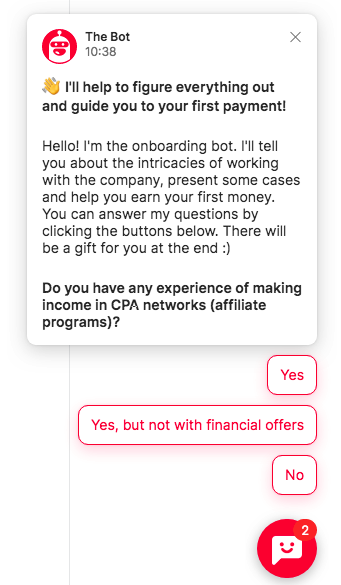
However, you don’t have to lure users to your admin panel to onboard them. Our FinTech customer Freedom24 used a different optimization strategy.
They reached out to users via a series of triggered emails, in which they:
- talked about the service’s benefits if a user finishes signup;
- offered the assistance of their support team;
- granted a free perk (in their case, it was 30 days of free Promo account usage).
What’s really important is that Freedom24 took into account that a lot of their clients were mobile users, so they launched push notifications to reach out to them too.
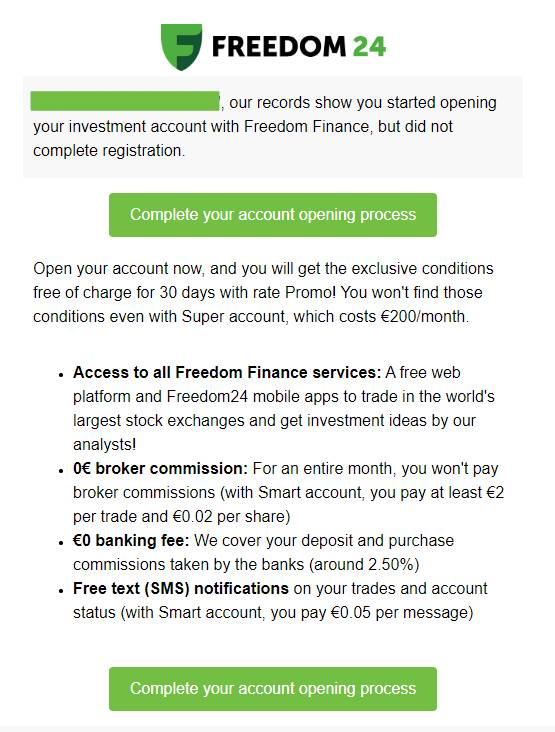
Growth marketing tools Dashly marketers use
There are tons of excellent growth marketing tools and services to make your life easier! Trust me. You’ll feel like a marketing superhero once you start using these gadgets. Let’s dive into a few growth marketing services that the Dashly marketers use.
- First up, we’ve got Google Analytics and Rick.ai. It’s like the Swiss Army knife of web analytics, helping you track user behavior, traffic sources, conversions, and much more. With this trusty sidekick, you can figure out what’s working and what needs a boost. Plus, it’s free, so there’s no excuse not to have it in your toolkit!
- We use Dashly reports and behavior tracking for more detailed info about customers. Thus, we know how many leads a new chatbot brings, users’ interests, button clicks, onboarding steps that make them abandon the product, etc.
- Conversion rate optimization tools like chatbots, triggered emails, live chat, pop-ups — everything for cross-channel marketing automation — we’re lucky to have it in the Dashly platform. Thus, we quickly test hypotheses and launch them without developers.
- Now, let’s talk about social media growth hacking tools. With all those platforms, managing your accounts can feel like herding cats. But don’t worry, Buffer’s got your back! This handy tool lets you schedule posts, analyze performance, and collaborate with your team. It’s like having a team of personal social media marketers that never sleep.
- For SEO we used to have Ahrefs, but now it is SEMrush.
- Finally, Trello, Favro, and Notion are like the superhero headquarters for managing projects and tasks. With its easy-to-use boards, lists, and cards, you can stay on top of your projects and collaborate with your team. It’s the perfect tool for keeping chaos at bay while you’re busy saving the (marketing) world.
It is far from the end of the possible solutions to assist your campaign growth efforts. There are no design tools, heatmaps, A/B tests, visual builders, etc.
To save your time, I collected a list of 50 proven tools for any goals and budget. Enjoy 👇
Thanks! Here’s your copy of 50 growth hacking tools
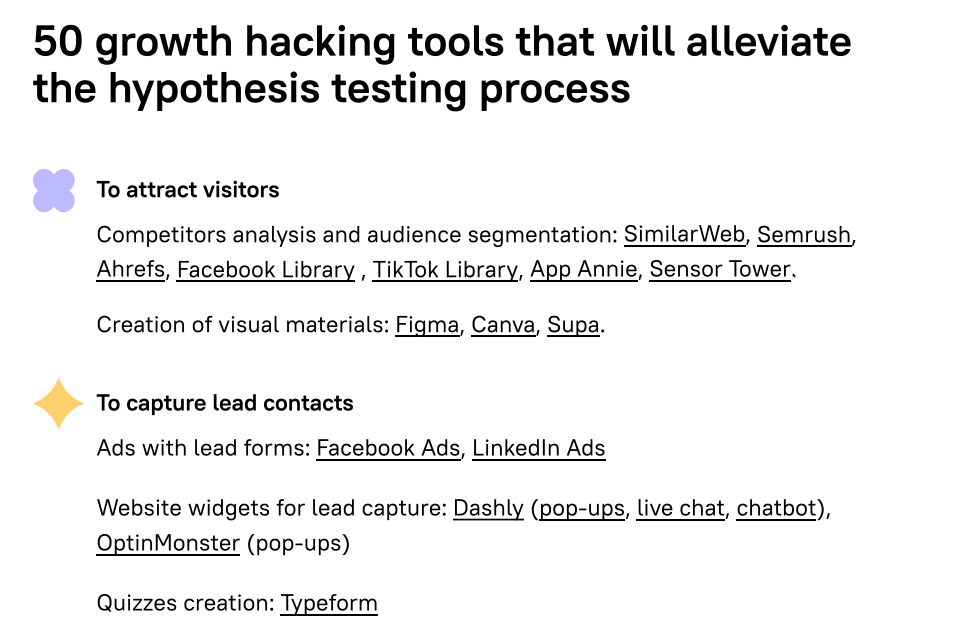
Learn from the best growth marketing experts and more
Here’s a list of growth marketing books that offer valuable insights and strategies to help you grow your business:
- “Traction: How Any Startup Can Achieve Explosive Customer Growth” by Gabriel Weinberg and Justin Mares
- “Hacking Growth: How Today’s Fastest-Growing Companies Drive Breakout Success” by Sean Ellis and Morgan Brown
- “The Lean Startup: How Today’s Entrepreneurs Use Continuous Innovation to Create Radically Successful Businesses” by Eric Ries
- “Hooked: How to Build Habit-Forming Products” by Nir Eyal
- “Contagious: Why Things Catch On” by Jonah Berger
- Marketing and Selling High-Tech Products to Mainstream Customers” by Geoffrey A. Moore
- “Building a StoryBrand: Clarify Your Message So Customers Will Listen” by Donald Miller
- “The Art of the Start 2.0: The Time-Tested, Battle-Hardened Guide for Anyone Starting Anything” by Guy Kawasaki
- “This Is Marketing: You Can’t Be Seen Until You Learn to See” by Seth Godin
Here’s a list of famous growth marketers that you to learn from:
| Sean Ellis | Coined the “growth hacking” definition and is the founder of GrowthHackers.com. He has helped scale companies like Dropbox, Eventbrite, and LogMeIn. |
| Andrew Chen | Currently a General Partner at Andreessen Horowitz, he was formerly the Head of Marketers team at Uber. Andrew has written extensively about growth marketing on his blog and is considered an expert. |
| Brian Balfour | Founder and CEO of Reforge, an advanced training program for growth marketers. Previously, he was the VP of Growth at HubSpot. |
| Rand Fishkin | Founder of Copy Hackers and Airstory, Joanna is a conversion copywriting expert who teaches businesses how to write a brand message that drives growth. |
| Noah Kagan | Founder of AppSumo and Sumo Group, Noah has a wealth of experience and shares his knowledge through his blog, podcast, and YouTube channel. |
| Joanna Wiebe | Founder of Copy Hackers and Airstory, Joanna is a conversion copywriting expert who teaches businesses how to write a brand message that drives business performance. |
Thanks! Here’s your list of must-read books on growth hacking
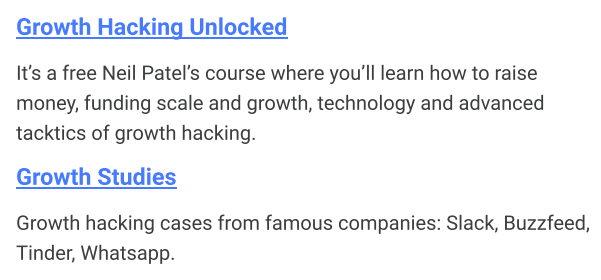
And also choose a growth marketing newsletter for a regular dose of valuable insights.
So, who is a growth hacking manager?
The difference between marketers and growth marketers is that the first focus on the top of the funnel, while the second dig deeper by focusing on the entire funnel. They are data-driven specialists that design and implement ideas based on the research. A growth marketer plays the role of a scientist that conducts experiments using analytical data and tries to see the task from various angles.
Growth marketers have a complex, resource-intensive job that requires a systematic work of a committed team focused on organic growth, revenue operations optimization (revops), customers retention metric, etc. Otherwise, it could be a waste of time and money.
Need more inspo for your growth strategy?
FAQ on growth marketing
What is growth marketing?
It is a data-driven strategy that focuses on the entire sales funnel and includes experiments to improve business KPIs individually for each company.
Who is a growth marketer?
It is an expert with a marketing background that has to set goals (key points to improve), create hypotheses based on the analytic data, and conduct experiments to achieve a desired goal.
Do I need a growth team?
For example, if you invest in brand ads and don’t get satisfactory engagement. Or if you went through a company’s annual reports and are not impressed with the numbers, you might consider introducing a growth marketing strategy, especially when it comes to the business in a competitive area of industry.
Does growth marketing work for each company?
It cannot work equally efficiently for each company. For example, startups shouldn’t rush with it. A marketing growth team would be an excellent investment for a company that has been growing steadily for N years and has resources to improve its performance and increase profit or clients loyalty.
How to launch products to maximize growth?
| Here are potential opportunities and strategies you can use to achieve rapid business success: |
| – release of the feature to the entire customer base; – open access to the feature for all users; – sending out news about the release to customers; – launching on Product Hunt and Hacker News; – registration on TechCrunch and press releases; – articles about the release in your blog and on external content platforms. |
What is growth hacking canvas?
The Growth Hacking Canvas is a visual framework that helps structure growth hacking strategies. It includes sections for objectives, target audience, acquisition channels, activation, retention, revenue, referral, key metrics, and experimentation. This tool encourages collaboration, brainstorming, and an iterative approach to optimizing growth initiatives.
What are proven SaaS growth marketing hacks?
Here are some SaaS growth hacks that can help you acquire, engage, and retain users:
- Offer a free version of your product with limited features, encouraging users to upgrade for more functionality. This model allows users to try your product before committing to a paid plan.
- Provide a limited-time free trial of your premium features, creating a sense of urgency for users to experience the full value of your product and increasing the likelihood of conversion.
- Incentivize users to refer friends or colleagues by offering them and their referral benefits, such as additional features, discounts, or extended trial periods.
- Create urgency with time-sensitive discounts, bonuses, or exclusive features, encouraging users to take action and sign up for your paid plans.
- Use in-app ads and messages, prompts, or tooltips to guide users through your product, highlight features, and encourage them to explore more functionalities, ultimately increasing retention and upsell opportunities.
What growth hacking / marketing solutions does Facebook provide?
Facebook growth marketing can include:
⭐ Regularly posting engaging content like images, videos, articles, and updates to your Facebook Page to attract and engage your audience.
⭐ Using Facebook’s advertising platform to create targeted ads for brand awareness, lead generation, or conversions.
⭐ Leveraging Facebook’s audience targeting features to reach people similar to your existing customers or leads.
⭐ Participating in or creating relevant Facebook Groups to engage with potential customers and build community around your brand.
⭐ Using Messenger for customer support, marketing automation, or chatbot-driven campaigns to engage with your audience more personally.
⭐ Hosting live videos, Q&As, or events to engage with your audience in real-time and showcase your brand personality.
Read also:
- Build Ideal Customer Profile Like a Pro Even If You’re Not [3 Templates]
- Customer Journey Map: Get To Know, Design, and Use Them
- How to Implement the Jobs to Be Done Theory to Portray Buyer Personas
- Revenue operations metrics: 10 metrics and KPIs to track your performance
- Product led growth metrics: 13 key indicators for SaaS companies to track
- PLG tools: Ultimate guide to the best instruments
- Benefits of Product led growth: 12 PLG benefits for your business
- Top 10 product led growth software your competitors use in 2023
- 10 product led growth companies that boost their development right now
- Sales led growth: What is it and why your business needs it
- Growth marketing case studies: 12 stories with detailed tactics and numbers achieved
